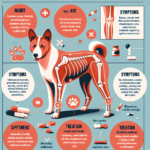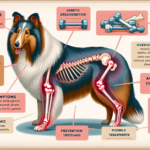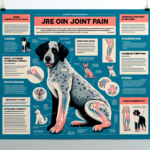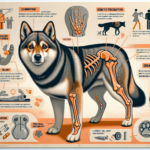Australian Cattle Dog Joint Pain: Causes, Symptoms, Prevention, and Treatment
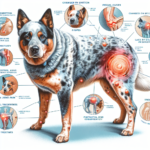
Introduction
The Australian Cattle Dog, also known as the Blue Heeler or Queensland Heeler, is a robust and energetic breed originally developed in Australia for herding cattle over long distances. Known for their intelligence, agility, and endurance, these dogs have a rich history dating back to the 19th century. They were bred by crossing the native Australian Dingo with various herding breeds, including the Collie and Dalmatian, to create a dog capable of handling the harsh Australian outback.
While Australian Cattle Dogs are generally healthy and hardy, they are not immune to certain health issues. Common concerns include deafness, progressive retinal atrophy, and joint-related problems. Joint pain, in particular, can significantly impact their quality of life, making it a crucial area of focus for owners and veterinarians alike.
Joint health is especially important for Australian Cattle Dogs due to their high activity levels and working nature. These dogs are often involved in physically demanding tasks, which can put extra stress on their joints. Ensuring good joint health can help maintain their mobility, comfort, and overall well-being.
Breed-Specific Joint Pain Risks
Genetic Predisposition
Australian Cattle Dogs are genetically predisposed to several joint-related issues, including hip dysplasia, elbow dysplasia, and arthritis. Hip dysplasia is a condition where the hip joint does not fit properly into the hip socket, leading to pain and mobility issues. Elbow dysplasia involves abnormal development of the elbow joint, causing lameness and discomfort. Arthritis, a degenerative joint disease, can also affect this breed, leading to chronic pain and stiffness.
Age-Related Risks
As Australian Cattle Dogs age, the risk of developing joint pain increases. While younger dogs may show few signs of joint issues, older dogs are more likely to experience symptoms due to the natural wear and tear on their joints. Owners should be particularly vigilant as their dogs approach middle age, typically around 5-7 years, and into their senior years.
Activity Level and Joint Stress
Australian Cattle Dogs are known for their high energy levels and need for regular physical activity. Whether they are working on a farm, participating in agility sports, or simply enjoying an active lifestyle with their owners, this constant activity can put significant stress on their joints. Over time, this can lead to joint pain and related issues, making it essential to balance exercise with proper joint care.
Common Symptoms of Joint Pain in Australian Cattle Dogs
General Symptoms
- Limping or favoring one leg
- Stiffness, especially after rest or sleep
- Reluctance to jump, run, or climb stairs
- Decreased activity or playfulness
- Visible discomfort or pain when touched
- Swelling around the joints
Breed-Specific Symptoms
In Australian Cattle Dogs, joint pain may manifest more prominently due to their active nature. Owners might notice a sudden decrease in their dog’s willingness to engage in activities they once enjoyed, such as herding, running, or playing fetch. Additionally, these dogs may show signs of pain or discomfort more acutely due to their typically high pain tolerance and stoic demeanor.
When to Consult a Vet
If you observe any of the above symptoms in your Australian Cattle Dog, it is essential to consult a veterinarian promptly. Early diagnosis and intervention can help manage joint pain more effectively and improve your dog’s quality of life. Regular veterinary check-ups are also crucial for monitoring joint health and catching any issues early.
Preventive Measures for Joint Health
Exercise Recommendations
Maintaining an appropriate exercise routine is vital for the joint health of Australian Cattle Dogs. While they need regular physical activity to stay healthy, it is essential to avoid overexertion. Low-impact exercises such as swimming, walking, and controlled play can help keep their joints healthy without causing excessive stress. Avoid activities that involve repetitive jumping or hard landings, as these can exacerbate joint issues.
Dietary Suggestions
A balanced diet rich in essential nutrients can support joint health in Australian Cattle Dogs. Consider incorporating foods or supplements that contain glucosamine, chondroitin, and omega-3 fatty acids, which are known to promote joint health. High-quality commercial dog foods often include these nutrients, but you can also consult your veterinarian for specific dietary recommendations tailored to your dog’s needs.
Weight Management
Maintaining a healthy weight is crucial for reducing joint stress in Australian Cattle Dogs. Excess weight can put additional pressure on the joints, exacerbating pain and discomfort. Monitor your dog’s weight regularly and adjust their diet and exercise routine as needed to keep them at an optimal weight. Your veterinarian can provide guidance on the ideal weight range for your dog based on their age, size, and activity level.
Early Screening and Monitoring
Early screening and regular monitoring can help catch joint issues before they become severe. Consider having your Australian Cattle Dog screened for common joint problems, such as hip and elbow dysplasia, especially if they are from a breed line known to have these issues. Regular veterinary check-ups and monitoring for any signs of joint pain can help ensure early intervention and better management of joint health.
Treatment Options for Joint Pain
Non-Surgical Treatments
Non-surgical treatments for joint pain in Australian Cattle Dogs include medications, physical therapy, and lifestyle adjustments. Anti-inflammatory medications and pain relievers can help manage pain and reduce inflammation. Physical therapy, including exercises and massage, can improve joint mobility and strength. Lifestyle adjustments, such as providing a comfortable bed and avoiding strenuous activities, can also help alleviate joint pain.
Surgical Options
In severe cases of joint pain, surgical intervention may be necessary. Common surgical options for Australian Cattle Dogs include hip replacement, elbow surgery, and arthroscopy. These procedures can help alleviate pain and improve joint function, but they come with risks and require a significant recovery period. Consult your veterinarian to determine if surgery is the best option for your dog.
Alternative Therapies
Alternative therapies such as acupuncture, hydrotherapy, and massage can also benefit Australian Cattle Dogs with joint pain. Acupuncture involves inserting thin needles into specific points on the body to relieve pain and promote healing. Hydrotherapy, or water therapy, allows dogs to exercise in a low-impact environment, reducing stress on the joints. Massage can help improve circulation, reduce muscle tension, and alleviate pain.
Lifestyle and Management Tips
Daily Care Routine
A consistent daily care routine can help manage and alleviate joint pain in Australian Cattle Dogs. This routine might include gentle exercise, a balanced diet with joint-supporting supplements, and regular veterinary check-ups. Providing a comfortable sleeping area and avoiding activities that strain the joints can also help manage pain.
Modifying the Home Environment
Making your home more comfortable for a dog with joint pain can significantly improve their quality of life. Consider adding ramps to help them navigate stairs or get onto furniture without jumping. Orthopedic beds can provide better support for their joints while they rest. Ensure that food and water bowls are at a comfortable height to reduce strain on their neck and joints.
Long-Term Management
Long-term management of joint pain in Australian Cattle Dogs involves a combination of regular veterinary care, appropriate exercise, a balanced diet, and a supportive home environment. Consistent monitoring and early intervention can help manage pain and maintain your dog’s mobility and quality of life. Working closely with your veterinarian to develop a comprehensive care plan tailored to your dog’s needs is essential for long-term success.
FAQs About Australian Cattle Dogs and Joint Pain
What are the early signs of joint pain in Australian Cattle Dogs?
Early signs of joint pain in Australian Cattle Dogs include limping, stiffness, reluctance to move, decreased activity, and visible discomfort when touched. If you notice any of these symptoms, consult your veterinarian for a thorough evaluation.
Can joint pain in Australian Cattle Dogs be prevented?
While it may not be possible to prevent joint pain entirely, you can take steps to reduce the risk and manage symptoms. Maintaining a healthy weight, providing appropriate exercise, and ensuring a balanced diet with joint-supporting nutrients can help promote joint health.
Are there specific exercises that are better for Australian Cattle Dogs with joint pain?
Low-impact exercises such as swimming, walking, and controlled play are better for Australian Cattle Dogs with joint pain. These activities help maintain mobility and strength without putting excessive stress on the joints.
What dietary supplements can help support joint health in Australian Cattle Dogs?
Dietary supplements that can support joint health in Australian Cattle Dogs include glucosamine, chondroitin, and omega-3 fatty acids. These nutrients help promote joint health and reduce inflammation. Consult your veterinarian for specific supplement recommendations.
When should I consider surgery for my Australian Cattle Dog’s joint pain?
Surgery should be considered for your Australian Cattle Dog’s joint pain if non-surgical treatments are not effective and the pain significantly impacts their quality of life. Consult your veterinarian to determine if surgery is the best option for your dog.
Conclusion
Joint pain is a common concern for Australian Cattle Dogs, but with proper care and management, you can help your dog maintain a healthy and active life. By understanding the breed-specific risks, recognizing early symptoms, and taking preventive measures, you can support your dog’s joint health. Regular veterinary check-ups, appropriate exercise, a balanced diet, and a supportive home environment are essential for managing joint pain and ensuring your dog’s well-being. Always consult your veterinarian for personalized advice and treatment options to keep your Australian Cattle Dog happy and healthy.

